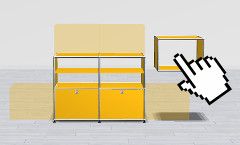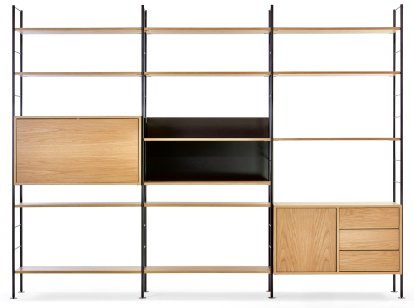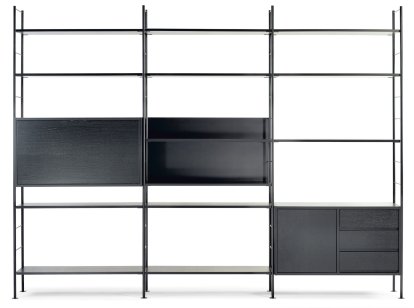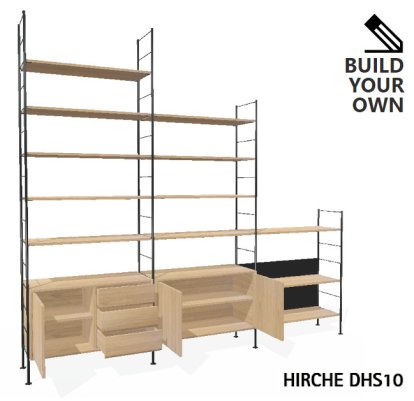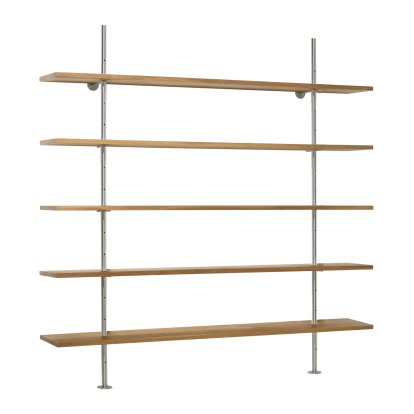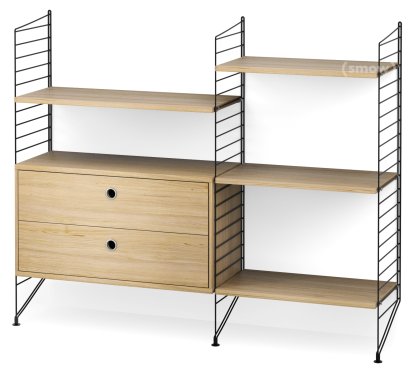DHS10 Hirche Shelf
by Herbert Hirche, 1954 — CHF 5’144.00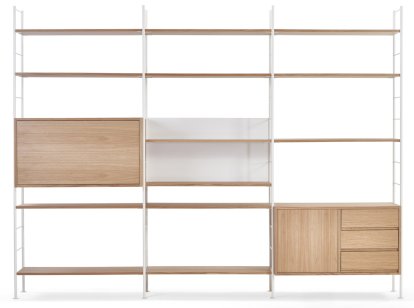
has been added to your wishlist.
Details
| Product type | Modular shelving |
| Dimensions | Height, ladder supports: 185.5 cm Height, cabinet elements: 43.6 cm Total width (incl. adjustable foot): 251.2 cm Depth, ladder supports: 32.6 cm Depth, shelf: 29.2 cm Depth, cabinet element: 35.8 cm |
| Colours | Shelves/cabinet elements   Backwall   Ladder supports   |
| Material | Ladder supports: steel tube (16 mm) and wire (6 mm), powder coated Backwall: MDF (8 mm), lacquered Shelves: birch multiplex (16 mm) with oak veneer, lacquered Cabinet elements: MDF (16 mm) open-pored black lacquered (RAL 9005) or oak veneer, colourless lacquered |
| Variants | More options in the configurator Many other shelf elements and combination options are available on request |
| Function & Properties | Elements can be individually configured |
| Delivery includes | Wall bracket included in delivery |
| Assembly | For safety reasons shelf must be mounted on the wall |
| Product presentation |  |
| Care | For cleaning a damp cloth and a mild detergent are recommended |
| Warranty | 24 months |
FAQ
What does the abbreviation DHS stand for?
Until the 1960s, the architect and product designer Herbert Hirche was very successful as a furniture designer with designs such as the DHS 10 living room shelf for the manufacturer Christian Holzäpfel. The abbreviation DHS stands for “Diplomarchitekt Hirche Stuttgart” and, in conjunction with the numbering, forms a kind of catalog raisonné - this was the form in which furniture was referred to in the tradition of New Living at that time.
How does the DHS 10 compare to the String shelving system?
The DHS 10 stacking shelf system was commissioned by the manufacturer Christian Holzäpfel from Herbert Hirche, and was intended as a light and flexible shelf as an alternative to the String shelf system by Nils and Kajsa Strinning. In contrast to the String shelving system, Hirche did not foresee his design mounting on the wall, while as the cabinet and drawer elements are veneered on all sides the DHS 10 shelf can not only be placed against the wall, but also used as a room divider.In addition to objects such as the DHS 1 lounger, the DHS 2 toy box, the DHS 4 children's desk, the DHS 6 side tables or the DHS 5 shelving, with the DHS 7 to 9 Hirche created a kitchen unit, a sideboard and a serving trolley for Christian Holzäpfel.
Why is Herbert Hirche's home furniture so close to the Knoll International aesthetic?
The DHS 20 program by Hirche for Christian Holzäpfel unveiled in 1956 at the Cologne furniture fair, included objects which were aesthetically very close to the furniture collections from Knoll International. This proximity was no coincidence: Knoll were strongly influenced by Mies van der Rohe whom Hirche cooperated with in the immediate pre-War years, and, logically, post-War continued to develop his pre-War understandings. In addition both Mies and Hirche were both active members of the pre-War Deutsche Werkbund, and post-War Herbert Hirche felt himself to be committed to this tradition.The DHS 20 was followed a year later by the DHS 30 office furniture system, supplemented by a version with fine wood veneer for the executive area known as the DHS 300.
What were the two biggest successes of Christian Holzäpfel?
Two of Christian Holzäpfel's greatest successes with the DHS furniture by Herbert Hirche were the furnishing of his new building for the German Embassy in Washington, furnishings commissioned by Egon Eiermann, and the furnishing of the new Paris UNESCO building designed by Zehrfuß + Nervi, which was inaugurated in 1958.In the Bauhaus year 2019, Richard Lampert presented a re-edition of the DHS 10 living room shelf in Cologne, along with other Hirche designs.
Quellen: Nicola von Albrecht, (2020). Herbert Hirche - Ein Protagonist der deutschen Nachkriegsmoderne. Online-Publikation (2020) via OPUS 4, Dokumentenserver der Universität der Künste Berlin.

